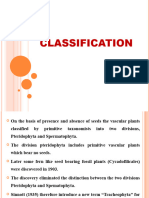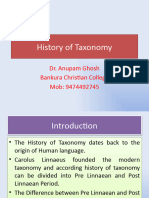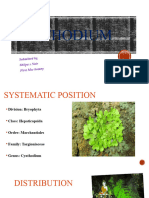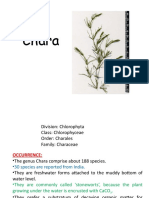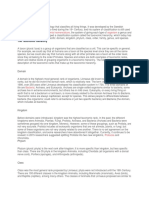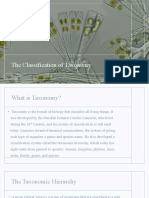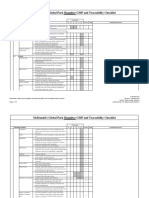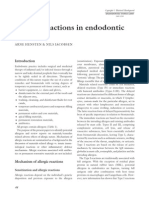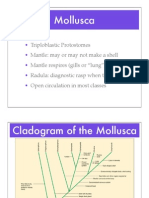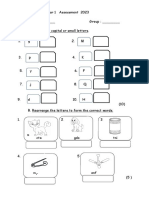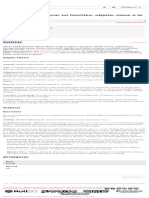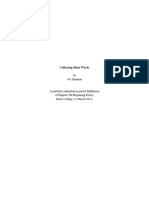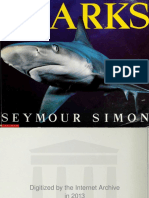Taxonomy
Taxonomy is a Field which deals with the process of describing, naming and classifications of organisms.
Taxonomy refers to a branch of science that deals primarily with the description, identification,
nomenclature, and classification of organisms. It aims to classify organisms in a hierarchical system or in
taxonomic ranks (e.g. domain, kingdom, phylum or division, class, genus, species) based on shared
characteristics or on phylogenetic relationships inferred from the fossil record or established by genetic
analysis. For example, organisms are classified into clades (i.e. a taxonomic group of organisms based on
homologous features derived from a common ancestor) in phylogenetic taxonomy. The person specializing
in this particular field is called a taxonomist. One such notable taxonomist is the Swedish botanist Carl
Linnaeus. He is considered as the father of taxonomy. One of his major contributions in taxonomy was a
system of classification referred to as Linnaean classification where organisms are categorized into taxa.
He was also the proponent of binomial nomenclature.
Domain is the highest (most general) rank of organisms. Linnaeus did invent some of the taxonomic ranks,
but he did not invent the domain rank, which is relatively new. The term domain wasn’t used until 1990,
over 250 years after Linnaeus developed his classification system in 1735. The three domains of life are
Bacteria, Archaea, and Eukaryota. Archaea are single-celled organisms similar to bacteria; some archaea
live in extreme environments, but others live in mild ones. Eukaryota, or every living thing on earth that is
not a bacterium or archaeon, is more closely related to the domain Archaea than to Bacteria. Taxonomic
ranks are always capitalized, except for species. This allows people to differentiate between bacteria (the
organisms; could refer to all bacteria or just two specific bacteria) and Bacteria (the domain, which includes
all bacteria).
Kingdom: For a long time, all life was separated into five or six kingdoms. These included kingdoms such
as animals, plants, fungi, protists, archaea, and bacteria. With new genetic data, we now know that some
protists are more closely related to animals, plants, and fungi than they are to other protists. This suggests
that the protist kingdom could be separated into multiple kingdoms. Thoughts are similar for the bacteria
and archaea kingdoms.
Phylum, plural phyla, is still a very broad classification but it splits kingdoms into several groups.
An example of phyla from the animal kingdom is Arthropoda which includes all insects, spiders,
crustaceans and more. All vertebrate animals belong to one phylum called ‘Chordata’.
Invertebrates are separated into many different phyla.
Class is a next level down. As mentioned earlier some classes from the phylum Chordata include
mammals, reptiles, and amphibians. Arthropod classes include the likes of insects and arachnids
(spiders, mites, and scorpions)
Order is more specific than class. Some of Linnaeus’ orders are still used today, such as
Lepidoptera (the order of butterflies and moths). There are between 19-26 orders of Mammalia,
depending on how organisms are classified—sources differ. Some orders of Mammalia are
�Primates, Cetaceans (whales, dolphins, and porpoises), Carnivora (large carnivores/omnivores),
and Chiroptera (bats).
Family is, in turn, more specific. Some families in the order Carnivora, for example, are Canidae
(dogs, wolves, foxes), Felidae (cats), Mephitidae (skunks), and Ursidae (bears). There are 12 total
families in the order Carnivora.
Genus (plural: genera) is even more specific than family. It is the first part of an organism’s
scientific name using binomial nomenclature; the second part is the species name. An organism’s
scientific name is always italicized, and the genus name is capitalized while the species name is
not. Genus and species are the only taxonomic ranks that are italicized. The scientific name for
humans is Homo sapiens. Homo is the genus name, while sapiens is the species name. All other
species in the genus Homo are extinct. Some were ancestral to humans, such as Homo erectus.
Others lived at the same time, were closely related, and interbred with Homo sapiens, such as
Homo neanderthalensis, the Neanderthals.
Species is the most specific major taxonomic rank; species are sometimes divided into subspecies,
but not all species have multiple forms that are different enough to be called subspecies. There are
an estimated 8.7 million different species of organisms on Earth, but the vast majority have yet to
be discovered and categorized. While each genus name is unique, the same species names can be
used for different organisms. For example, Ursus americanus is the American black bear, while
Bufo americanus is the American toad. The species name is always italicized, but never
capitalized. It is the only taxonomic rank that is not capitalized. In scientific articles where the
species name is used many times, it is abbreviated after the first full use by using just the first letter
of the genus name along with the full species name. Homo sapiens is abbreviated to H. sapiens.
Domain:Eukaryota
Kingdom:Animalia
Phylum:Chordata
Class:Mammalia
Order:Primates
Family:Hominidae
Genus:Homo
Species: Homo sapiens
Binomial nomenclature is a system of naming a species often in a Latinized form and in two
parts, i.e. the generic name genus and the specific epithet. The binomial nomenclature is a system
used to name a species of a particular organism. It is often based in Greek or Latin language.
Although Latin is now a defunct language, the naming of organisms is still being classified using
this language. Apart from using these languages, the binomial nomenclature entails two parts: (1)
generic name (genus) and (2) specific epithet. An example is Yucca filamentosa, a plant of the
Yucca genus and the unique filamentosa species. When applying the binomial nomenclature
system, the name of the species is written in italics or enclosed within the quotation marks ("").
The genus name begins in capital letter whereas the specific epithet, in small letter. The genus may
also be written by abbreviating it to its initial letter. For instance, based on the previous
example,Yucca filamentosa abbreviated to Y. filamentosa. The name given to a particular species
�is called binomial name or scientific name. Classification is the systematic grouping of living
things based on characteristics, hierarchical, or phylogenetic relationships or simply the systematic
arrangement of entities into categories according to differing characteristics.
Why should we name organisms?
• Name acts as means of reference
• It aids communication in science
• Avoids the use of descriptive words when referring to an object
Biological species concept (BSC)
The concept of a species as a group of populations whose members are capable of interbreeding
successfully and are reproductively isolated from other groups. This concept became influential
during the late 19th and early 20th centuries, largely replacing the typological species concept
favoured by pioneer naturalists. Central to the concept is the role of sexual reproduction. This
maintains the broad uniformity of species' members through genetic recombination and sharing of
a common gene pool. Isolating mechanisms prevent breeding, and hence gene flow, between
different groups, thus ensuring genetic divergence between groups. However, the concept cannot
be applied to exclusively asexual organisms, such as certain groups of fungi and bacteria. Nor does
it account satisfactorily for the many instances in which interspecies mating does occur, especially
in plants, fungi, and prokaryotes. It defines species in terms of interbreeding. For instance, Ernst
Mayr (1942) defined a species as follows: "species are groups of interbreeding natural populations
that are reproductively isolated from other such groups’. Most modern textbooks use this concept
which is also called a reproductive or isolation concept. Mayr's definition excludes unusual or
artificial matings that result from deliberate human action, or occur only in captivity, or that
involve animals capable of mating but that do not normally do so in the wild. In this concept, two
aspects are stressed.
Problems In Applying The Species Concept To Living Organisms
Cloning: Many organisms reproduce asexually, so we do not know whether they fit the concept
or not. For example, bacteria usually clone themselves, and even when they do go through
something like sexual reproduction, they do not exchange genes the way that most prokaryotes do.
This objection may apply even to "advanced" creatures. For example, some lizards and
salamanders do not (ever) have sexual reproduction. Their populations are all females, and they
lay eggs which have never been fertilized, and hatch as females which carry on the cycle. Among
plants, asexual reproduction is even easier, as many plants reproduce by budding. Strawberries
and Bermuda grass are easy examples, but dandelions also reproduce without sex, and redwoods
can.
�Variation: The Oregon junco is a small bird, Junco oreganus, that ranges from southern Alaska
to Baja California. The gray-headed junco, Junco caniceps lives in the Great Basin; the slate-
colored junco, Junco hyemalis, lives east of the Rockies, and the white-winged junco, Junco
aikeni, lives in the Black Hills of South Dakota. In their particular regions, they look and behave
like perfectly good species. However, there are narrow strips of territory where any two species
overlap slightly. In those corridors they interbreed freely. So ornithologists have been forced to
place all these birds into one species, the "dark-eyed junco", J. hyemalis, which happens to have
at least four "subspecies". Local birders in central California typically still call the California bird
the Oregon junco. This example is one of hundreds showing that the biological species is difficult
to apply, even by gifted biologists looking at conspicuous and well-known birds.
Hybrids:. Typically, individuals that contain some mixture of the species' genes are
called hybrid individuals that live in a hybrid zone where the species overlap and interbreed.
Usually hybrids are less fertile than "pure" members of the two species, so usually hybrids are not
numerous and hybrid zones are narrow. Hybrid zones are a problem. Although the parent
populations are exchanging genes, they remain largely genetically distinct. There must be some
sort of dynamic equilibrium between the adaptation of the species to their different habitats,
despire some genetic exchange across the hybrid zone. Hybrid zones can probably tell us a lot
about the relative genetic isolation of populations, and perhaps about mechanisms of speciation.
The biological species concept definition cannot be used to describe bacteria or other asexually
reproducing organisms, because the Concept States that a species is a group of organisms that can
interbreed and produce viable fertile offspring.
BIOLOGICAL KEYS
Taxonomists often present organized written descriptions of the characteristics of similar species
so that other biologists can identify unknown organisms. Taxonomic identification is the
recognition of the identity or essential character of an organism. These organized descriptions are
referred to as taxonomic keys, dichotomous keys, biological keys, identification keys etc.
The most helpful characters in terms of identifying organisms are those that have more than one
state represented among the group of organisms under study.
A character is any feature of an organism that can be measured in some way. The character is any
recognizable trait, feature, or property of an organism. These are often morphological/anatomical
features (e. g. number of appendages, type of coelom, presence of a vascular tissue) but can also
include behavioral features such as songs in the case of birds, color, or ecological features such as
the time of day an organism is active (nocturnal, crepuscular, etc.).
A character state is defined as an alternate form of a particular character. For example, if the
character is the arrangement of leaves on a plant stem, then opposite, alternate, and whorled are
all character states for this one character. Leaf arrangement then is a multistate character, because
it can appear in more than one state. Another example would be the shape of the edge of a leaf.
This single character could have multiple states: smooth, wavy, saw-tooth, etc.
Most identification keys are said to be “artificial,” meaning that they do not necessarily reflect the
true evolutionary relationships, or phylogenies, of organisms.
�Taxonomic Keys
A taxonomic key is a simple tool used to identify a specific object. A taxonomic key is one of the
most useful tools available to scientists trying to identify an unknown organism. Systematists rely
on keys to help identify known organisms and determine whether they have discovered a new
organism entirely. Taxonomic keys are useful tools guiding researchers towards the known name
of an organism. However, all taxonomic keys are not created equally. They are often created on a
regional level or for a particular group of organisms (i.e., Plants of the Great Lakes Region,
Argentinean Monocots etc.). So it is important to pick a key that represents the diversity of the
region or group of organisms you are interested in examining.
Types of Taxonomic Keys
1. Dichotomous key
2. Poly-clave keys
Dichotomous Keys
Keys in which the choices allow only two (mutually exclusive) alternative couplets are known as
dichotomous keys. In constructing a key, contrasting characters are chosen that divide the full set
of possible species into smaller and smaller groups i.e. the statements typically begin with broad
characteristics and become narrower as more choices are required.
Each time a choice is made, a number of species are eliminated from consideration and the range
of possible species to which the unknown specimen may belong is narrowed. Eventually, after
sufficient choices have been made, their range reduces to a single species and the identity of the
unknown plant is revealed. Dichotomous comes from the Greek root dich meaning “two” and
temnein meaning “to cut“.
Couplets can be organized in several forms. The couplets can be presented using numbers
(numeric) or using letters (alphabetical). The couplets can be presented together or grouped by
relationships. There is no apparent uniformity in presentation of dichotomous keys.
Types of dichotomous keys
Indented Keys (also called yoked):
Indents the choices (leads) of the couplet an equal distance from the left margin. The two choices
of the couplet are usually labelled 1 and 1′ or la and lb. It is not necessary that the choices are
numbered, but it helps. The user goes to the next indented couplet following the lead that was
selected.
Bracketed Keys:
�Provides both choices side-by-side. The choices of the couplet must be numbered (or lettered). It
is very helpful if the previous couplet is given. This key has exactly the same choices as the first
example. The choices are separated, but it is easy to see the relationships. While this key might be
more difficult to construct, it gives more information to the user.
Example of a dichotomous key: Dichotomous key for Insects
1a. With wings................................................................................................................. 5
1b. Without wings........................................................................................................... 2
2a. Ant-like body………………………………………......................................... 3
2b. Not an Ant-like body .............................................................................................. 4
3a. Ant-like body with a narrow waist (ants)........................................Hymenoptera
3b. Ant-like with a wide waist (termites) ........................................................Isoptera
4a. With an 2 antennae-like appendages located at the end of the abdomen which is
used .as a "spring" (springtails) ...................................................................Collembola
4b. Has 3 pair of legs, but no wings, and no springy legs..............Immature insect
5a. With only a single pair of wings; the second pair of wings modified into a pair
of knob-like organs known as halteres (flies) ..................................................Diptera
5b. With two pair of wings ............................................................................................ 6
5c. With piercing, sucking mouthparts (like a straw)..................................................7
5d. Forewings leathery, but not hard; hindwings membranous and folded under
the forewings....................................................................................................................8
6a. The wings are equal in size with a long slender abdomen…………………….
(dragonflies and damselflies)............................................................................ Odonata
6b. The first pair of wings much larger than second and held straight up over the
body; with two or three long, antennae-like appendages at the end of the
�abdomen(mayflies) ................................................................................Ephemeroptera
7a. Forewings half leathery, half membranous, while hindwings entirely membranous;
wings makes an “X” when folded on the back (true bugs) .......................Hemiptera
7b. Forewings either entirely membranous or entirely leathery; held rooflike over
the body (aphids, scales, leafhoppers, and cicadas) ..................................Homoptera
8a. Chewing mouthparts; hind legs often enlarged, adapted for jumping………….
(grasshoppers, katydids, and crickets)..........................................................Orthoptera
8b. Hind legs are not enlarged and adapted for jumping.........................................9
9a. Front legs have many spines and are held in front of them in a bent “prayer like”
position; with large eyes (praying mantids) ...................................................Mantodea
Disadvantages Of Using A Dichotomous Key
• The key may not include all potential variations in the species;
• The key may rely on features not present in that season;
• The key may not include “all” species of interest;
• One may misinterpret a feature or make a mistake
Poly clave keys
In biology or medicine, a multi-access key is an identification key which overcomes the problem
of the more traditional single-access keys (dichotomous or polytomous identification keys) of
requiring a fixed sequence of identification steps. A multi-access key enables the user to freely
choose the characteristics that are convenient to evaluate for the item to be identified.
Although good single-access keys will try to start with characters that are reliable, convenient to
observe and generally available throughout most of the year, it is often impossible to achieve this
for all taxa in a key. A multi-access key lets the user adapt the key to the particular organism that
is being identified and to the circumstances of identification (e.g. field or laboratory). Multi-access
keys may be printed in various ways (tabular, matrix, formula style, etc.) but are more commonly
used as computer-aided, interactive keys. This key is based on the identification of organisms by
a process of elimination. In a written poly clave key there is a series of characters and character
�states. Each state is followed by a number or code for the species that possess that feature. The
user needs to select any character and then copy down the list of species that possess the feature.
Then the user has to select another character and eliminate any species that is not common to both
lists. This process has to be continued until the specimen is identified.
(a) Advantages of Poly clave Keys:
I. They are easy to use.
II. They allow multi-entry i.e. the user can start anywhere. This is a significant advantage because
the user can rely on characters that are most easy to observe, rather than having to deal with
characters that may not be present in the specimen or are poorly developed.
III. They are order-free i.e. the user can work in any direction with any character.
IV. They are faster.
V. They are easily computerized. In fact, these keys are most commonly used in this form. Paper
versions are typically large and unwieldy because each character needs to list all possible taxa.
























